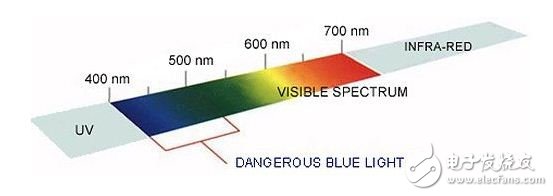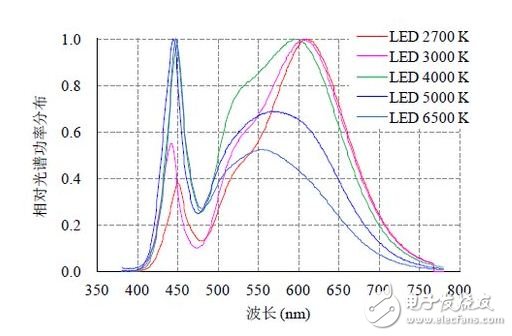
Privacy statement: Your privacy is very important to Us. Our company promises not to disclose your personal information to any external company with out your explicit permission.

LED lamp is a new type of light source after incandescent lamp, fluorescent lamp and energy-saving lamp. It has high luminous efficiency, but many people do not understand its light-emitting principle and spectral characteristics, and it is inevitable that it will not damage the light emitted by it. eye. Spectrally, the light emitted by LEDs is very different from that of traditional incandescent lamps and fluorescent lamps. The so-called "spectrum" means that the light emitted by an object has a "rainbow".
Three color LEDs
The light of traditional incandescent lamps and fluorescent lamps has the same seven colors of "red orange, yellow, green, blue, and purple" as sunlight.
However, the general LED emits only three colors of "RGB", where R is red, which means red light; G means green, which is green light; and B means blue, which is blue light.
These three color LEDs, the most important and most basic of the "blue LED" between 400nm and 500nm.
The particularity of blue light

Where is Blu-ray?
Look at the "Rainbow" picture above. From left to right, the order is ultraviolet light, visible light and infrared light. The wavelength range of visible light is between 400 nm and 700 nm, and the wavelength range from 400 nm to 500 nm is blue, so this band is called blue light.
The basic unit of light is called a photon. The wavelength of a photon is inversely proportional to the frequency. The wavelength of blue light is short, so the frequency is high. According to Einstein and Planck's calculation formula of light quantum energy, we can know that the energy of photons is equal to the product of Planck's constant and the frequency of photons, so the photon energy of blue light is higher than that of red and green light. So that we can use blue light to "excite" other colors of light, such as yellow light can be "excited" by the blue light.
Blue LED technology once won the Nobel Prize in Physics
The blue LED technology was developed in 1998, and the technology won the 2014 Nobel Prize in Physics. It appears that the tall blue LED is made by encapsulating a GaN chip and yttrium aluminum garnet (YAG). The GaN chip emits blue light with a wavelength λ equal to 465 nm and a wavelength bandwidth of approximately 30 nm.
How does a white LED emit white light?
So, how does the white LED of the household produce white light? As already mentioned above, the energy of the blue photon is high, so it can be used to excite fluorescence. Generally, the blue light generated by the blue LED is used to generate yellow light on the phosphor (similar to the principle of the fluorescent lamp, the light of the fluorescent lamp is emitted by the ultraviolet light on the phosphor on the inner wall of the fluorescent tube). After the yellow light is excited by the blue light, they are shot together from the LED. We will feel as if we have seen the white light. In fact, this is just a combination of blue and yellow colors.
Let's make an analogy. Blu-ray is the "mother" and Huang Guang is the "son". Their mother and son groups form the single family of "white light".
Because of this principle, many manufacturers in order to improve the brightness of white LEDs, directly increase the intensity of blue light, so the yellow light will increase accordingly, and the brightness of the resulting white light will increase, but this will cause us to Explain the "blue excess" problem.
Actual measurement of the spectrum of LED lights
The figure below shows the measured spectrum of different types of white LEDs. We can see that the "blue light" between 400nm and 500nm has a strong peak.

This shows an LED that looks white, but in fact its spectrum does contain a strong blue component.
The effect of blue light on the retina
So, since Blu-ray is the "mother" of white LEDs, what is the feeling of the eyes on blue light?
The tissue used to receive light in the human eye is called the retina. If the brightness of the 400–500 nm blue light band in the light source is too high, the eye may cause photochemical damage to the retina after long-term direct view of the light source. The damage is mainly divided into two categories: damage caused by direct reaction of blue light with visual pigment in visual photoreceptor cells, and damage caused by reaction of blue light with lipofuscin in retinal pigment epithelial cells. These photochemical reactions produce large amounts of cytotoxic free radicals that disrupt the normal growth and function of retinal cells.
We can also consider the harmfulness of blue light from another angle. Why can't people's eyes accept the "excessive blue light" from blue LEDs? Because humans evolved in the solar system, according to the Wien displacement law of blackbody radiation, we can calculate the center wavelength of sunlight at around 550 nm through the temperature of the sun's surface, while the blue LED center wavelength is 465 nm, which deviates from the sun. The central wavelength of light, so from an evolutionary perspective, our human eyes cannot accept "excessive" blue light.
LED blue light excess detection standard in life
Generally speaking, products that have been listed on the national quality inspection by regular manufacturers will not have hidden dangers of excessive blue light. However, some manufacturers of LED lamps do not pay attention to controlling the intensity of blue light. The blue light in the LED lamps they produce is “excessive” and damages the blue radiation of the eyes.
In life, there are many sources of light that can emit blue light - Yuba, flat panel displays, LED neon lights, fluorescent lights, liquid crystal displays, ipads, large-screen mobile phones, etc. all have background light sources, all of which contain short-wave blue light. If the blue light is "excessive", it will affect the retina, so you should avoid looking directly at the light source with your eyes, and pay attention to the use time, and close your eyes every 20-30 minutes for a while.
If you are worried about the problem of "blue light excess" in LED lights or other electrical appliances purchased, you can follow the "National Standard of the People's Republic of China GB/T 20145-2006 / CIE S 009 / E: 2002 (Photobiosafety of lamps and lamp systems) ) to determine whether the blue light of the LED light is excessive - the standard gives the upper limit of the luminous flux of the blue light at a specific spatial angle. (The content of the specific standard is not listed here in detail, and interested readers can check it out by themselves.)
However, for LED lamps sold on the market, how to judge the LED blue excess is a complicated problem. For example, the LED light below, from its published "voltage and frequency" is unable to estimate whether the blue light is excessive, because voltage and frequency are electrical indicators, and blue light is an optical indicator. And its claimed "light flux" is an optical indicator, but it is only the total luminous flux of white light, not the luminous flux of blue light, so it is difficult for the average consumer to judge whether this light is excessively blue.

In the angle of eye-protection, I recommend that you choose a low-intensity luminaire when purchasing LED lights. Conditional people can use a spectrometer to measure the spectrum of the light emitted by the LED light - if the intensity of the blue light emitted by this LED light is much stronger than the blue light in the sun, then don't buy it.
WOSEN is a professional manufacturer and supplier of Led Flood Light, Led Street Light, Led Solar Light, etc. For more information, please visit https://www.wosenled.com/ or contact admin@wosenled.com or WhatsApp +86-13425434349
Письмо этому поставщику

Privacy statement: Your privacy is very important to Us. Our company promises not to disclose your personal information to any external company with out your explicit permission.

Fill in more information so that we can get in touch with you faster
Privacy statement: Your privacy is very important to Us. Our company promises not to disclose your personal information to any external company with out your explicit permission.